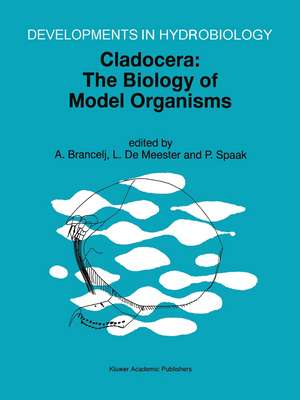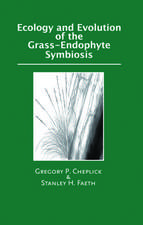Cladocera: the Biology of Model Organisms: Proceedings of the Fourth International Symposium on Cladocera, held in Postojna, Slovenia, 8–15 August 1996: Developments in Hydrobiology, cartea 126
Editat de A. Brancelj, L. de Meester, P. Spaaken Limba Engleză Paperback – 5 noi 2012
Their fast and easy asexual reproduction offers a wide range of possibilities for studies in many fields of research: genetics, ecology, ecotoxicology, etc. In some ways they are the Drosophila of the present day. Their global distribution makes them of special interest from a phylogenetic and biogeographic as well as an ecological point of view.
Apart from the proceedings of previous symposia, there are no other books which cover the whole range of aspects. These proceedings update the last symposia as well as including completely new information on certain fields of research.
Target groups are research scientists within ecology, systematic biology, evolutionary biology and population biology. The book could also be a useful source of information for special courses for students of the above mentioned topics.
Din seria Developments in Hydrobiology
- 18%
 Preț: 1229.10 lei
Preț: 1229.10 lei - 18%
 Preț: 959.98 lei
Preț: 959.98 lei - 18%
 Preț: 963.91 lei
Preț: 963.91 lei - 15%
 Preț: 648.24 lei
Preț: 648.24 lei - 15%
 Preț: 637.89 lei
Preț: 637.89 lei -
 Preț: 378.23 lei
Preț: 378.23 lei - 15%
 Preț: 644.95 lei
Preț: 644.95 lei - 18%
 Preț: 952.09 lei
Preț: 952.09 lei - 20%
 Preț: 558.87 lei
Preț: 558.87 lei - 18%
 Preț: 1833.65 lei
Preț: 1833.65 lei -
 Preț: 393.59 lei
Preț: 393.59 lei -
 Preț: 406.54 lei
Preț: 406.54 lei - 18%
 Preț: 1226.73 lei
Preț: 1226.73 lei - 18%
 Preț: 956.99 lei
Preț: 956.99 lei -
 Preț: 388.87 lei
Preț: 388.87 lei - 24%
 Preț: 1060.51 lei
Preț: 1060.51 lei - 18%
 Preț: 1229.28 lei
Preț: 1229.28 lei - 20%
 Preț: 569.30 lei
Preț: 569.30 lei -
 Preț: 368.79 lei
Preț: 368.79 lei - 24%
 Preț: 817.46 lei
Preț: 817.46 lei - 18%
 Preț: 958.25 lei
Preț: 958.25 lei - 18%
 Preț: 953.03 lei
Preț: 953.03 lei -
 Preț: 384.75 lei
Preț: 384.75 lei - 24%
 Preț: 1582.91 lei
Preț: 1582.91 lei - 24%
 Preț: 1051.68 lei
Preț: 1051.68 lei - 18%
 Preț: 943.57 lei
Preț: 943.57 lei - 18%
 Preț: 1235.76 lei
Preț: 1235.76 lei - 24%
 Preț: 800.02 lei
Preț: 800.02 lei - 24%
 Preț: 803.55 lei
Preț: 803.55 lei - 18%
 Preț: 948.29 lei
Preț: 948.29 lei
Preț: 385.92 lei
Nou
Puncte Express: 579
Preț estimativ în valută:
73.85€ • 77.26$ • 61.34£
73.85€ • 77.26$ • 61.34£
Carte tipărită la comandă
Livrare economică 29 martie-04 aprilie
Preluare comenzi: 021 569.72.76
Specificații
ISBN-13: 9789401060844
ISBN-10: 9401060843
Pagini: 320
Ilustrații: XII, 303 p.
Dimensiuni: 195 x 260 x 17 mm
Ediția:1997
Editura: SPRINGER NETHERLANDS
Colecția Springer
Seria Developments in Hydrobiology
Locul publicării:Dordrecht, Netherlands
ISBN-10: 9401060843
Pagini: 320
Ilustrații: XII, 303 p.
Dimensiuni: 195 x 260 x 17 mm
Ediția:1997
Editura: SPRINGER NETHERLANDS
Colecția Springer
Seria Developments in Hydrobiology
Locul publicării:Dordrecht, Netherlands
Public țintă
ResearchCuprins
Taxonomy, Systematics and Biogeography.- On the history of studies on cladoceran taxonomy and morphology, with emphasis on early work and causes of insufficient knowledge of the diversity of the group.- Subgeneric differences in head shield and ephippia ultrastructure within the genus Bosmina (Baird) (Crustacea, Cladocera).- Structure of thoracic limbs in Bosminopsis deitersi Richard, 1895 (Anomopoda, Branchiopoda).- Sensory and glandular equipment of the trunk limbs of the Chydoridae and Macrothricidae (Crustacea: Anomopoda).- Alona stochi n.sp. — the third cave-dwelling cladoceran (Crustacea: Cladocera) from the Dinaric region.- Moina ephemeralis n.sp. from Central Europe.- A checklist of the littoral cladocerans from Mexico, with descriptions of five taxa recently recorded from the Neovolcanic Province.- The cladocera of the Godthåbfjord area SW Greenland.- Life History and Ecological Genetics.- Offspring size in Daphnia: does it pay to be overweight?.- Phenotypic plasticity of Daphnia life history traits in response to predator kairomones: genetic variability and evolutionary potential.- Life tables of Moina macrocopa (Straus) in successive generations under food and temperature adaptation.- Preliminary experiments on resource competition between a migrating and a non-migrating clone of the hybrid D. galeata × hyalina.- Electron transport system (ETS) activity and respiration rate in five Daphnia species at different temperatures.- Hybridization in the Daphnia galeata complex: are hybrids locally produced?.- Among-populational genetic differentiation in the cyclical parthenogen Daphnia magna (Crustacea, Anomopoda) and its relation to geographic distance and clonal diversity.- Behaviour.- Ideal free distribution in Daphnia? Are daphnids able to consider both thefood patch quality and the position of competitors?.- Mating behaviour in Moina brachiata (Jurine, 1820) (Crustacea, Anomopoda).- Light-induced swimming of Daphnia: can laboratory experiments predict diel vertical migration?.- The change in phototactic behaviour of a Daphnia magna clone in the presence of fish kairomones: the effect of exposure time.- Differential behaviour and shifts in genotype composition during the beginning of a seasonal period of diel vertical migration.- Size distribution of Daphnia longispina in the vertical profile.- Trophic Interactions and Community Structure.- The trophic role of the marine cladoceran Penilia avirostris in the Gulf of Trieste.- Ecological similarities and differences among litoral species of Ceriodaphnia.- The effect of different fish communities on the cladoceran plankton assemblages of the Kis-Balaton Reservoir, Hungary.- Importance of water-level fluctuation on population dynamics of cladocerans in a hypertrophic reservoir (Lake Arancio, south-west Sicily, Italy).- Long-term dynamics of small-bodied and large-bodied cladocerans during the eutrophication of a shallow reservoir, with special attention for Chydorus sphaericus.- Assessment of the importance of fish predation versus copepod predation on the life history traits of Daphnia hyalina.- Effects of competitors and Chaoborus predation on the cladocerans of a eutrophic lake: an enclosure study.- The relevance of size efficiency to biomanipulation theory: a field test under hypertrophic conditions.- Chydorid assemblages in the sedimentary sequence of Lake La Cruz (Spain) subject to water level changes.- Invited Contributions: Personal Views on the Future of Cladoceran Research.- The future of cladoceran research.- Some suggestions for future cladoceran research.- The future of cladoceran genetics: methodologies and targets.- Cladoceran studies: where do we go from here?.
Recenzii
`... I feel that the volume is to be recommended to students and researchers and university librearies mainly due to the diversity of topics presented.'
International Review of Hydrobiology, 84 (1999)
International Review of Hydrobiology, 84 (1999)














